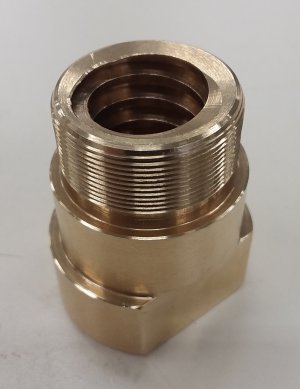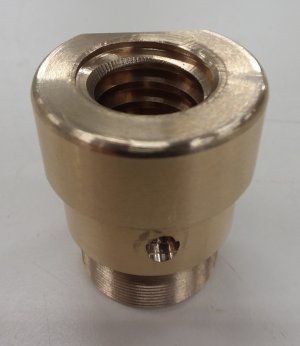I hope I chose the right place to put my first real post.
A couple of years ago I bought a Boyar Schultz 612 surface grinder. I didn't really do much in the way of refurbishing it at the time. I did take it apart and cleaned and degreased everything (except the spindle head) and painted it. A surface grinder is one machine I had never used before and so there was quite a learning curve for me but thanks to forums like this and some YouTube videos I managed to get some decent results. But there were a couple of times in using it that I experienced a problem with the spindle dropping a bit while in use and I ruined a couple of parts because of it. Long story short, I ended up discovering that the elevation screw nut was the real culprit.
Like most older machines with lead screws there is a sweet spot that has more wear in that area. And my elevation screw falls into this category. But the brass nut that's mounted in the top of the spindle housing had much more wear. Because of the constant weight of the spindle and direct drive motor you could not tell how much backlash or wear there was unless you took it apart. The nut had a lot of slop at the non-worn ends of the screw but in the worn area and with all that weight the nut would actually slip and cause the spindle to drop. After hours of research I could not find anybody that had a replacement elevation nut. But I have an 11 inch Logan lathe...........
As many of you I'm sure already know that Boyar Schultz in their infinite wisdom used a non-standard thread for the elevation screw. I suppose it may have had something to do with the gear ratio used for the hand wheel. But it is 3/4 x 6 2/3 TPI Acme thread. I saw in a post somewhere where another hobbyist had my same issue and he had a 10 inch Logan. His 2 change gears were 24 and 48 and he was told to just get a gear that would give him the correct ratio. I'm only telling this part of the story so anybody else attempting this doesn't make the same nubie mistake that I did. Well my Logan has 36 and 72 tooth change gears. Since at one particular QC gear box setting the 36 gear gives you 10 TPI and the 72 one 5 TPI. So my math was simple - the 36 tooth difference is divisible by 3 so either add 12 to 36 or subtract 24 from 72. Well, a 48 tooth gear was kinda close but didn't give me 6 2/3 TPI. Luckily, I found another post and realized I had to use that algebra stuff to figure out that I needed a 54 tooth gear (simplified it's 36 divided by .6666666).
So after finding a 54 tooth gear on eBay I was finally able to make my nut. I decided to use SAE-660 bronze as that seemed to be the overwhelming opinion for a part like this. This was my first time use with this material and what a pleasure it was to machine. The nut is fairly straight forward to make on the lathe but there is a couple of operations best done on a mill. One is machining a flat area on the large diameter which is necessary for clearance of a casting "bump" on the inside of the spindle housing. The other feature is a small hole drilled on an angle to allow oil to lubricate the screw and nut. Here is a couple of pictures of the finished nut. If anyone is interested I can provide a sketch with dimensions and tooling information. For those of you who have gotten to this point in my post I hope I've provided some entertainment and help and not rambled on too much.
A couple of years ago I bought a Boyar Schultz 612 surface grinder. I didn't really do much in the way of refurbishing it at the time. I did take it apart and cleaned and degreased everything (except the spindle head) and painted it. A surface grinder is one machine I had never used before and so there was quite a learning curve for me but thanks to forums like this and some YouTube videos I managed to get some decent results. But there were a couple of times in using it that I experienced a problem with the spindle dropping a bit while in use and I ruined a couple of parts because of it. Long story short, I ended up discovering that the elevation screw nut was the real culprit.
Like most older machines with lead screws there is a sweet spot that has more wear in that area. And my elevation screw falls into this category. But the brass nut that's mounted in the top of the spindle housing had much more wear. Because of the constant weight of the spindle and direct drive motor you could not tell how much backlash or wear there was unless you took it apart. The nut had a lot of slop at the non-worn ends of the screw but in the worn area and with all that weight the nut would actually slip and cause the spindle to drop. After hours of research I could not find anybody that had a replacement elevation nut. But I have an 11 inch Logan lathe...........
As many of you I'm sure already know that Boyar Schultz in their infinite wisdom used a non-standard thread for the elevation screw. I suppose it may have had something to do with the gear ratio used for the hand wheel. But it is 3/4 x 6 2/3 TPI Acme thread. I saw in a post somewhere where another hobbyist had my same issue and he had a 10 inch Logan. His 2 change gears were 24 and 48 and he was told to just get a gear that would give him the correct ratio. I'm only telling this part of the story so anybody else attempting this doesn't make the same nubie mistake that I did. Well my Logan has 36 and 72 tooth change gears. Since at one particular QC gear box setting the 36 gear gives you 10 TPI and the 72 one 5 TPI. So my math was simple - the 36 tooth difference is divisible by 3 so either add 12 to 36 or subtract 24 from 72. Well, a 48 tooth gear was kinda close but didn't give me 6 2/3 TPI. Luckily, I found another post and realized I had to use that algebra stuff to figure out that I needed a 54 tooth gear (simplified it's 36 divided by .6666666).
So after finding a 54 tooth gear on eBay I was finally able to make my nut. I decided to use SAE-660 bronze as that seemed to be the overwhelming opinion for a part like this. This was my first time use with this material and what a pleasure it was to machine. The nut is fairly straight forward to make on the lathe but there is a couple of operations best done on a mill. One is machining a flat area on the large diameter which is necessary for clearance of a casting "bump" on the inside of the spindle housing. The other feature is a small hole drilled on an angle to allow oil to lubricate the screw and nut. Here is a couple of pictures of the finished nut. If anyone is interested I can provide a sketch with dimensions and tooling information. For those of you who have gotten to this point in my post I hope I've provided some entertainment and help and not rambled on too much.


